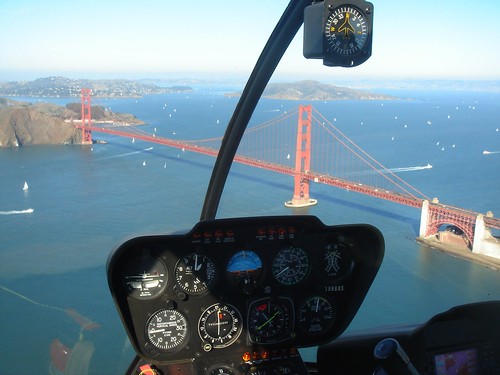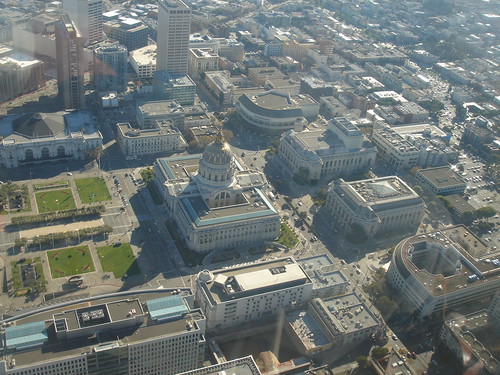
Well, almost exactly one year after my "discovery flight", I passed my PPL-H checkride and became a qualified helicopter pilot. To my pleasure and surprise, my wife - who has never been at all keen on helis and until now has never flown in one - agreed to be my first passenger. So last weekend I did my first helicopter "Bay Tour", departing from Palo Alto towards the coast, with a slight detour to fly over the Montebello Ridge vineyards so she could see them from the air. Then out to San Gregorio, up the coast over Half Moon Bay, over the Golden Gate and back over the city. I've done this numerous times in airplanes, but the view from the heli is much better and of course you're lower too. The flight was a success from all points of view, with a very happy passenger who agreed - despite her attachment to our plane - that this was even better.
One of the hardest parts of flying helis, for me anyway, was to get a really smooth pickup. Hovering seems impossible at first, but after about five hours it's under control and getting better. Autorotations are fun, and if you're used to landing the Pitts then they don't seem too dramatic. Getting them right is tricky and takes some fairly aggressive manouvering, and (in my opinion) you can never practice them enough. But in the end, pickups were the hardest.
Here's the problem. While you're sitting firmly on the ground, the position of the controls isn't affecting anything. Hence, you have no feedback about whether they're in the right position or not. As soon as the skids completely leave the ground, you're flying, even though you're only an inch off the ground, and everything depends on the position of the cyclic and the pedals. A touch too much left cyclic and right pedal, and you're whizzing off to the left while spinning round to the right - not good, especially if you're in a confined area or on soft ground.
Instructors and textbooks say the same thing - lift the collective slowly until you're "light on the skids", correct the control position, then lift further. Easy to say, harder to get a feel for. It's just like learning coordinated turns in a plane - the instructor says, "but surely you can feel it, without even looking at the ball?" And you say (or at least I did), "errr, no, I can't". Now I can feel it, after over 1000 hours and 100+ hours of aerobatics, but it took a while.
So my experience was, you so-so-gently pull up on the collective, waiting to feel the heli come alive as the weight comes off the skids. And then it starts to turn or to move, and in an instant of panic you yank up the collective and you're three feet off the ground and you've zoomed off several feet from your starting point, before you brought things back under control. This is not the way to pass a checkride, something my instructor made very clear to me.
The fix, for me, was an exercise where I deliberately set the cyclic and the pedals way off where they should be, then, as the collective came up, gradually corrected them as I felt things starting to move. After a few times doing that, I'd overcome the panic instinct to yank on the collective, and after that it was just practice. It's very satisfying - now that I can feel what "light on the skids" means - to make small corrections just before the thing leaves the ground, and have it move smoothly and vertically through those first few inches.
The other hard thing, getting close to the checkride, was slope work, where you delberately have the weight partly supported by one skid and partly by the rotor. The amazing videos you see of helicopters touching a steep hillside, yet still flying, are all about this. Again it's all about feel for the controls during the critical moments, and tiny movements of the collective. It's a real feeling of victory when you can hold the heli, half on the ground and half off, then sooo gently let it down onto the other skid. And even better when you can smoothly lift it off again. It takes a lot of practice.
Finally, a couple more pictures from our Bay Tour. There are more on Flickr.
One of the hardest parts of flying helis, for me anyway, was to get a really smooth pickup. Hovering seems impossible at first, but after about five hours it's under control and getting better. Autorotations are fun, and if you're used to landing the Pitts then they don't seem too dramatic. Getting them right is tricky and takes some fairly aggressive manouvering, and (in my opinion) you can never practice them enough. But in the end, pickups were the hardest.
Here's the problem. While you're sitting firmly on the ground, the position of the controls isn't affecting anything. Hence, you have no feedback about whether they're in the right position or not. As soon as the skids completely leave the ground, you're flying, even though you're only an inch off the ground, and everything depends on the position of the cyclic and the pedals. A touch too much left cyclic and right pedal, and you're whizzing off to the left while spinning round to the right - not good, especially if you're in a confined area or on soft ground.
Instructors and textbooks say the same thing - lift the collective slowly until you're "light on the skids", correct the control position, then lift further. Easy to say, harder to get a feel for. It's just like learning coordinated turns in a plane - the instructor says, "but surely you can feel it, without even looking at the ball?" And you say (or at least I did), "errr, no, I can't". Now I can feel it, after over 1000 hours and 100+ hours of aerobatics, but it took a while.
So my experience was, you so-so-gently pull up on the collective, waiting to feel the heli come alive as the weight comes off the skids. And then it starts to turn or to move, and in an instant of panic you yank up the collective and you're three feet off the ground and you've zoomed off several feet from your starting point, before you brought things back under control. This is not the way to pass a checkride, something my instructor made very clear to me.
The fix, for me, was an exercise where I deliberately set the cyclic and the pedals way off where they should be, then, as the collective came up, gradually corrected them as I felt things starting to move. After a few times doing that, I'd overcome the panic instinct to yank on the collective, and after that it was just practice. It's very satisfying - now that I can feel what "light on the skids" means - to make small corrections just before the thing leaves the ground, and have it move smoothly and vertically through those first few inches.
The other hard thing, getting close to the checkride, was slope work, where you delberately have the weight partly supported by one skid and partly by the rotor. The amazing videos you see of helicopters touching a steep hillside, yet still flying, are all about this. Again it's all about feel for the controls during the critical moments, and tiny movements of the collective. It's a real feeling of victory when you can hold the heli, half on the ground and half off, then sooo gently let it down onto the other skid. And even better when you can smoothly lift it off again. It takes a lot of practice.
Finally, a couple more pictures from our Bay Tour. There are more on Flickr.


No comments:
Post a Comment